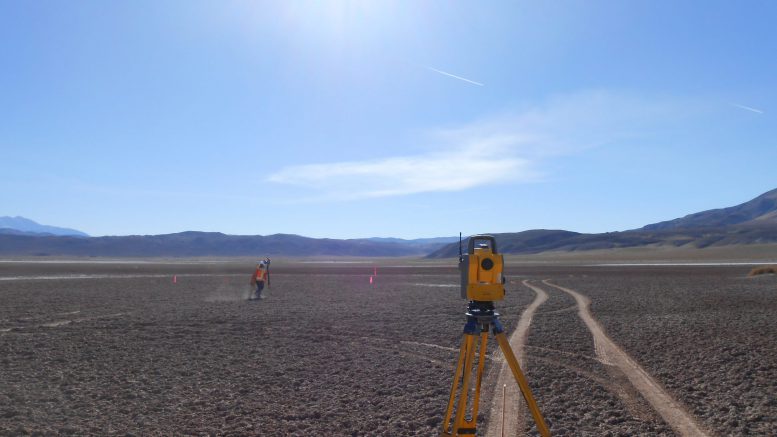Next year is looking to be a pivotal one for HeliosX Lithium & Technologies Corp. (TSXV: HX; US-OTCQB: HXLTF) as it plans to mobilize drills and equipment to its Nevada and Alberta-based assets. The Calgary-based company is eager to put some more concrete data behind the theses underpinning its portfolio, says CEO Christopher Brown in an interview with The Northern Miner.
The executive says HeliosX has been preoccupied with housekeeping since taking over Dajin Lithium in the past year. Following the closing of a $4.7 million financing currently underway, Brown said he expects HeliosX will be in a good position to get out in the field and drill during 2023.
HeliosX holds a 100% interest in 403 placer mineral claims covering 32 sq. km of the Teels Marsh area in Nevada. It is near the Clayton Valley and Albemarle’s (NYSE: ALB) Silver Peak operations, the sole lithium producer in the U.S.
This area of the Teels Marsh was extensively prospected by the well-known prospector, ‘Borax’ Smith. In 1867, Smith began processing borax and salt deposits. This property eventually became part of the early history of the giant borax producer, U.S. Borax, today a wholly owned subsidiary of one of the world’s largest mining companies, Rio Tinto (NYSE: RIO; LSE: RIO; ASX: RIO).
With the discovery of lithium and boron in the Teels Marsh brines, it was concluded that these brines were formed by the evaporation of water leaching from volcanic ash originating from the ancient super eruption of the nearby Long Valley Caldera, in California, says Brown. This is the same ash fall environment that contributed to the lithium brines of the nearby Clayton Valley.
“I think we’re in a very good position to likely drill in 2023,” says Brown. “It’s a matter of evaluating whether we drill it ourselves or bring in other parties, depending on what they bring to the table.”
Brown says Teels Marsh entails a geothermally active complex, which could represent a new replenishable source of lithium. “Geothermally based lithium brines could potentially be a new system of rechargeable lithium, which, if that’s the case, could be a game changer for the industry,” says Brown.

Lithium brine sites in Nevada. Dajin Resources image
Importantly, the company has all the water rights it could need should the project be developed.
Meanwhile, just across a ridge from Albemarle’s Silver Peak operation is HeliosX’s 11.3-sq.-km Alkali Lake asset. The company has recently added more acreage around the acquired Dajin holdings.
“On a geological basis, even though Dajin held the core of what they believed was the key component of Alkali Lake, I believe the depositional environment is much larger,” says Brown. “The association of a closed basin with an arid environment, a geothermal system and plentiful sources of lithium suggest that Alkali Lake valley may host significant lithium-rich brines.”
Diversified focus
HeliosX is also building a prospective lithium brines portfolio in Canada’s oilfields in Alberta.
Brown says the Fox Creek area, located about 260 km northwest of Edmonton has been geologically identified as one of the most prospective regions in Alberta for higher concentration lithium brines and larger geological complexes. The lithium brine-bearing formations and carbonate units of interest are the Leduc Formation of the Woodbend Group and the Swan Hills Formation of the Beaverhill Lake Group. To date, initial indications are that the highest concentrations tend to be associated with the Swan Hills carbonate complexes.
Brown says the region of investigation covers more than 75,000 sq. km at prospective depths between 2,220 to 4,000 metres. Average thicknesses could range between 12 to 45 metres.
“The volumetric opportunities in this region are in the billions of barrels of lithium brine resource in place,” says Brown. “The focus is on identifying regions which combine the ‘complete picture’ of future commerciality, which includes surface access, infrastructure, Indigenous consultation, protected parks, species migration patterns, reservoir depth, and lithium concentration.”
The company hopes to conclude drilling and pilot testing trials in Alberta later in 2023.
Meanwhile, subsidiary Dajin Resources owns a significant land position in northwestern Argentina, part of an area known as the ‘Lithium Triangle’ where it has been reported that 80% of the world’s supply of lithium is found in flat salt lake basins, also known as ‘salars’ or brines.
HeliosX controls about 930 sq. km in the Guayatoyoc basin.
“With our partner Pluspetrol Resources, next year, we were hoping again to put down a couple of wells in the basin. Seismic testing has been great. We clearly see a very thick section of sedimentary basin down to easily 1,800 metres. The Orocobre and Lithium Americas (TSX: LAC; NYSE: LAC) assets only go down to about 1,000 meters of sedimentary depth, so we have a much larger, thicker pay potential,” says Brown.
Direct lithium extraction
The success of emerging direct lithium extraction technologies underpins HeliosX’s value strategy.
“There is continuously an evolution of systems for direct lithium extraction,” says Brown. “Our partner in Argentina today has 12 independent technologies for lithium extraction in its research facilities. That gives you a sense that no one great solution will take over the industry anytime soon,” he says.
The evolution of this technology continues today. “I foresee today’s young minds will continue to evolve direct extraction technologies to make it more efficient.”
For now, HeliosX remains relatively agnostic to the extraction technology itself. “We deal, for example, in Canada, working with a group based out of the University of Calgary working on lithium extraction years before it was in fashion. And so that’s what I like about the university system, is that it encourages this out-of-box thinking,” says Brown.
At 49¢, the company’s shares are down 48% over the past 12 months, having tested a high and low of $1.31 and 42¢ per share. It has a market cap of $17.7 million.


Be the first to comment on "HeliosX to drill Nevada assets next year"